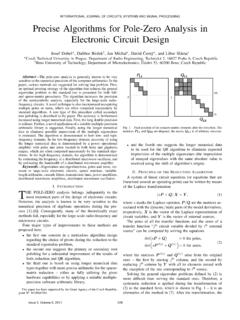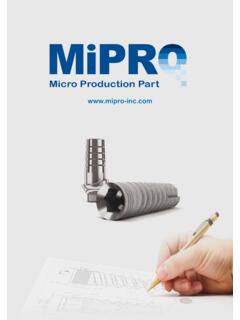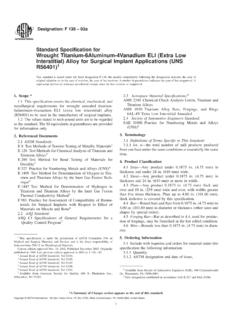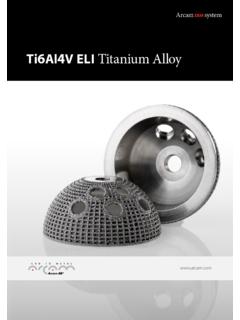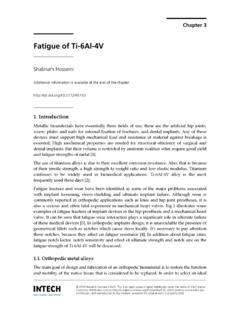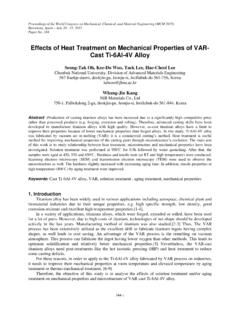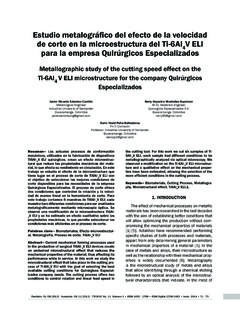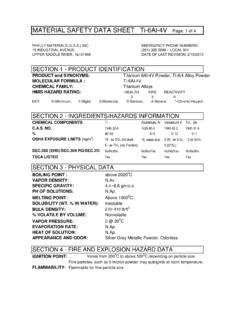Transcription of Fatigue Life Prediction of Titanium Implants with Titanium ...
1 Abstract Most of mechanical components in the engineering are frequently subjected to multi-axial loading, which also applies to medical engineering. The cyclic-loading can lead to sudden Fatigue failure. In present work the Fatigue life of cylindrical Titanium components of dental Implants made from Titanium alloys 6Al-4V ELI and 6Al-7Nb were studied. Contrary to surface treatments used in industry, the main goal of Titanium dioxide deposition is to improve Implants biocompatibility. The effect of surface treatment on Fatigue life of implant was tested experimentally. Two sets of experimental samples differed in surface layer thickness, so that its influence can be compared. Its Fatigue behaviour was studied and predictive models were tested. Seventeenth different models were applied and analysed in order to obtain the best way to predict Fatigue life of implant. Two different types of Implants were tested.
2 First type of implant uses abutment screw to fix the crown. This type has four parts. Second type of dental replacement has only three components. This type utilizes abutment polygonal thorn to fix the crown. Experiments show that, the effect of Titanium dioxide surfaces on Implants mechanical properties is considered negligible. Therefore Implants Fatigue life is not dependent on dioxide layer thickness. The Gon alves- Araujo- Mamiya criterion was found the best in Implants Fatigue Prediction . The Prediction of Fatigue life of polygonal thorn is more complicated, so its Prediction is gives inferior results contrary to the first type of implant. Keywords Fatigue testing, Bending-torsion loading, Titanium dioxide, Biocompatibile surface, Dental replacement, Abutment screw S. Major studied at the Brno University of Technology. He was working at the Institute of Theoretical and Applied Mechanics, Academy Science of Czech Republic, Prague.
3 He was working at the Charles Univestity of Prague, The Faculty of Medicine, The Institute of Medical Physics and Engineering. S. Major is working at the University of Hradec Kr lov . (corresponding adress: University of Hradec Kr lov , Faculty of Education, Department of Technical Education. Hradec Kr lov , Rokitansk ho 62, Hradec Kr lov III, 500 03, Czech Republic, e-mail: @ ). V. Kocour studied at the university Palack ho Univesity in Olomouc, Faculty of Natural Science, Department of Applied of Physics and Metrology and he also studied at the Department of Optics and Optoelectronics. V. Kocour was also working at the at the Institute of Theoretical and Applied Mechanics, Department of Optical. V. Kocour was studied at the Czech Technical University Prague Faculty of Transportation. V. Kocour was also working at the Faculty of Mechanical Engineering of Czech Technical University Prague.
4 He was researcher at Department of Measuring Techniques, Instrumentation and Metrology of this fakulty. Vladim r Kocour was taught mathematics at the Czech Technical University. Vladim r Kocour is specialist in the stereogrammetry and optical methods used in metalography and material research. The full adress o Faculty of Transportation, Czech Technical University, Zikova 1903/ 4 Prague, Czech Republic, (e-mail: J. Bryscejn is working at The Theoretical and Applied Mechanics, Academy of Science, 190 00 Prague 9, Proseck 809/76, (e-mail: I. INTRODUCTION XPERINCE from the operation of many devices shows well that components subjected to the repeated loading will fail after a certain number of cycles. This will happen even in the case that loading amplitude is deep below ultimate tensile stress, respectively below yield stress. The Fatigue degradation can be described as progressive and localized structural damage, this process caused significant damage in all areas of human activity [1] - [16].))
5 Microscopic cracks will begin to form at the surface when the local value of above a certain threshold. This happens in places where the stress concentrators are present, in the corners and at the sharp edges or in places where material defects occur. These material defects can be often connected with fault thermal treatment or surface deposition. When local crack was generated, it will be growing and after some time will reach a critical size, and the structure will suddenly fracture. As has already been said, the nominal maximum stress values are less than the yield stress limit of the metals. Fatigue failure occurs when a material is repeatedly subjected to external forces. This loading force is not necessarily described by periodic functions, loading is not described by periodic function such as sine function and others. An example of such non-periodic loading can be a dental implant [7], [14].
6 The dental implant consists of three or four main parts [7]. These components are: ceramic crown that is attached to the thorn or abutment screw and cylindrical housing. This abutment thorn or screw is inserted in the housing box, which is ingrown in the bone of the jaw. The abutment thorn has shape of conical thread or polygonal prism. The housing box (often called fixture) has internal cavity which serves to fasten the bolt or polygonal horn. This cavity has an internal thread or its cross-section is polygonal in the case of using polygonal thorn. Similar component as housing box in the jaw is often part of ceramic crown and this component serve to fast the thorn and the crown. It should be recounted, that most often solution is based on combination both approaches. The bottom section of thorn is a screw and its upper section is polygon (this section is mostly shorter than bottom section of thorn, see ).
7 In some cases the abutment is another part of assembly. The abutment can be straight (this is a common form) or angled. An angled abutment is used for replacement of aslant growing teeth in the case that the implant must hold same slope as surrounding teeth. Fatigue Life Prediction of Titanium Implants with Titanium Dioxide Surface Stepan Major, Vladim r Kocour and Jan Bryscejn E INTERNATIONAL JOURNAL OF MECHANICS Volume 11, 2017 ISSN: 1998-4448 288 In this article, the biological causes of the implant failure are not analyzed. Therefore, here is only a brief mention about reasons for the body rejection of implant as a foreign body. This process can be associated with various inflammations and other diseases [8], [9], [16]. This paper is devout only to mechanical causes of the implant failure, respectively to Fatigue failure of a threaded or thorn caused by repeated forces. The thorn with thread can be considered as an example of cylindrical or conical sample with notch under bending- torsion loading.
8 II. MATERIAL OF Implants Majority of metal components used in dental implantology as well in medical engineering generally [7], [8], [9], [16] are manufactured from Titanium alloys . Arguably, the most appropriate Titanium alloys used in medicine are 6Al-4V ELI alloy and 6Al-7Nb alloy. The abbreviation ELI in denomination of the first alloy means Extra-Low Interstitials. Thus, Titanium alloy 6Al-4V ELI is characterized by very low content of interstitial atoms. The main reason for reduce the concentration of interstitial atoms is that these atoms diffuse in the body. The interstitial atoms of vanadium are considered as harmful and carcinogen or cytotoxic. The Titanium alloy 6Al-4V ELI (ASTM standard: Grade 23 alloy) is very close to the Titanium alloy 6Al-4V (ASTM standard: Grade 5 alloy), which is intended for industry and its mechanical properties are practically the same.
9 The mechanical properties of Titanium alloy 6Al-4V ELI are: Elastic modulus E = MPa, ultimate strength 893=u MPa, yield stress 827=y MPa, crack growth properties are characterised by constants =C and These two constant are known from the Paris-Erdogan law. Crack growth properties were measured according to ASTM E647 [7], [8], [9], [18]. Due to the small dimensions of the implant, only first third of the stress curve was used obtained from this measurement was used for determination of stress crack growth parameters C and m. These values are therefore somewhat higher, than in the case of parameters whose values are determined from the entire loading curve. Because these values are higher than the values obtained from the entire curve, it is likely that the Fatigue life will be slightly underestimated, reability of design will be increased. The Titanium alloy 6Al-7Nb (ASTM standard: ASTM F 1295) was especially developed for medical use as alternative for 6Al-4V alloy.
10 The mechanical properties of Titanium alloy 6Al-4V ELI are: Elastic modulus E = 112 MPa, ultimate strength 895=u MPa, yield stress 819=y MPa, crack growth properties are characterised by constants =C and III. SURFACE TREATMENT OF Implants One of the most common ways to improve components resistance to the external influences is modification of components surface. By changing surface layer properties of machinery parts it is possible to increase both corrosion resistance and their load-capacity. In case of medical engineering, the first task of surface layer deposition is upgrading of biocompatibility [7], [8], [9], [16], [19].The metallic alloy of which dental replacement is made, can release harmful particles in the patient body. Release of these particles can be explained by corrosion. This corrosion is caused by Implants contact with body fluids. Another important factor in Implants failure is deposition of biological sediments on the implant surface.
